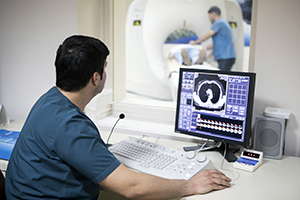Pancreatic Pseudocysts and Cysts

If a painful lump in your upper abdomen accompanied by nausea or vomiting is making it difficult to eat or digest you may want to diagnose or rule out a pancreatic cyst or pseudocyst. It can also be caused by a hard blow to your abdomen or by pancreatitis .
Cysts and pseudocysts are collections of tissue and fluids that form in the pancreas. While they usually aren’t dangerous or life-threatening, a ruptured cyst can create an emergency medical condition. Getting medical attention if you have cyst symptoms is very important.
To speak with a pancreatic cyst specialist today in Wittman, call (410) 266-3613 or contact Annapolis Integrative Medicine online.
Pancreatic cyst and pseudocyst symptoms
In many cases, people with pancreatic cysts experience no symptoms and the cysts usually resolve on their own. These are often discovered during diagnostic imaging for another condition.
However, if you’ve received a hard blow to your abdomen or have recently had pancreatitis, you should get medical attention for the following symptoms:
- nausea and vomiting
- pain in your upper abdomen that can radiate through to your back
- a lump in your upper abdomen
- difficulty eating or digesting food
A ruptured cyst is a much more dangerous condition—in some cases, it can even be fatal. If you’re experiencing these symptoms, don’t wait—call 911 or get emergency medical attention right away:
- vomiting blood
- fainting
- weak or rapid heartbeat
- severe abdominal pain
- losing consciousness
Causes of cysts and pseudocysts
Most often, this painful inflammation of the pancreas occurs after pancreatitis . Your pancreas is a small, tadpole-shaped organ located beneath your stomach in the digestive tract that aids digestion and helps regulate blood sugar.
Pancreatitis occurs when digestive enzymes secreted by the pancreas begin digesting pancreatic tissues, causing swelling, bleeding, and blood vessel damage. The more often this happens, the more scarring occurs, and the result can be chronic pancreatitis.
Gallstones , small pebble-like deposits that form in the gallbladder can also cause pancreatic cysts. Located near your pancreas, this organ stores bile produced in your liver . Gallstones can be tiny or as big as a golf ball, and they can block the ducts that drain digestive fluids from your pancreas, leading to pancreatitis.
Cysts typically form when the ducts that carry your pancreatic juices get blocked. Cysts are small sacs lined with epithelium that contain fluid and may or may not be cancerous.
There are two main types of pancreatic cysts. Serous cysts contain a thin fluid and tend to be non-cancerous. Most mucinous (containing a thicker fluid) cysts are also benign, but there a few subtypes that can be cancerous.
Mucinous cystic neoplasms (MCN) usually develop in ovarian tissue. Intrapapillary mucinous neoplasms (IPMN) contain many small fingerlike projections usually found near the main pancreatic duct. These two types can be cancerous and require meticulous medical care.
Pseudocysts are not contained within an enclosed sac, but form within a space inside your pancreas surrounded by fibrous tissue. These don’t contain inflammatory pancreatic fluid or semisolid matter. They’re typically round or oval, non-cancerous, affect about 1 in 1000 adults each year, and comprise about 80% of all cystic lesions.
Diagnosing cysts and pseudocysts
First, your medical provider will examine you and discuss your current symptoms, your medical history, and any medications you’re taking. If a pancreatic cyst is suspected, you’ll likely undergo a number of tests to diagnose or rule out the condition.
These include:
- transabdominal ultrasound: sound waves detect cysts, or gallstones that can cause cysts
- computerized tomography (CT): images the pancreas and surrounding anatomy; more detailed than simple ultrasound
- magnetic resonance imaging (MRI): provides a sharp image of fluids and debris than CT scan or ultrasound imaging
- endoscopy : under anesthesia, a long, flexible tube is inserted down the throat with ultrasound guidance to create real-time images and allow fluid sample collections for laboratory analysis
- endoscopic retrograde cholangiopancreatography (ERCP): creates image of bile ducts and pancreatic duct structure
How are cysts and pseudocysts treated?
As with any medical procedure, results of cyst or pseudocyst treatment will vary from patient to patient depending on age, genetics, general health, condition severity, follow-up care, and environmental factors.
Your provider will look at your imaging results and determine the best course of action. If you have a pseudocyst without any symptoms, it’s likely that you’ll be advised to wait and see whether it resolves (as pseudocysts often do). Your provider will probably advise another round of imaging tests within 1-3 months to monitor the pseudocyst’s size and determine whether it’s growing or shrinking.
If you’re experiencing pain and other symptoms, the pseudocyst must be drained. You’ll receive anesthesia so your provider can insert a stent (a small tubular device that relieves obstruction) using an endoscope. Then, your provider will insert an ultrasound-guided needle into your abdomen and suction out the fluid in an attempt to collapse the cyst. This typically solves the problem permanently.
Another method is percutaneous catheter drainage, which follows the same basic method but involves placing a hollow tube inside the incision to drain the fluid through the endoscope. This fluid is usually sent for lab analysis to ensure it doesn’t contain cancer cells.
If these methods aren’t sufficient, then surgery may be recommended. This is performed laparoscopically—through small incisions in your abdomen using tiny instruments and a lighted scope. Your surgeon will drain the fluid and send it for lab analysis.
You’ll receive antibiotics after your procedure to prevent infection, particularly staph infection, which is a common but serious post-surgical complication. Laparoscopic surgery is usually an outpatient procedure.
Pancreatic cancers typically cause no symptoms until they reach advanced stages, at which time they’re nearly impossible to treat successfully. At the time of diagnosis, more than 80% of patients show metastasis (development of a secondary malignant growth) or the tumor is advanced beyond surgical removal, so 5-year survival rates are extremely low (about 5%)1.
Taking care of your pancreas is vitally important. You can do this by taking preventative measures to minimize your chances of having problems later in life.
Preventing pancreas damage
Taking these preventative measures is the best way to avoid pancreatic disorders:
Limit alcohol intake
Alcohol can wreak havoc on your vital organs if you drink too much for too long. Alcohol is a toxin, and consuming more than one drink per day can damage your pancreas and liver.
Alcohol is the commonest cause of chronic pancreatitis and the second-most common cause of pancreatitis2. It contains toxic chemicals called metabolites (acetaldehyde, FAEEs, and ROS), that damage the pancreas on a cellular level. When alcohol alters the pancreas’ ability to create alcohol-metabolizing enzymes, accumulation of these harmful metabolites cause tissue damage that, in time, becomes irreversible.
Maintain good nutrition
A well-balanced diet rich in dark green vegetables, fresh fruits, whole grains, and no processed foods, high-fat foods or sugars is a strong way of avoiding many pancreatic disorders.
You should avoid fatty and fried foods, as well as full-fat dairy products like whole milk. High-fat diets raise your body’s triglyceride levels (the amount of fat in your bloodstream) and increase your risk of getting gallstones and pancreatitis.
These foods have shown effectiveness in promoting pancreas health:
- cruciferous veggies: broccoli, brussels sprouts, cauliflower, and cabbage are full of antioxidants that promote strong immune function and may stave off pancreatic tumors
- lemons, limes, and kiwi: encourage the release of digestive enzymes from your pancreas
- English marigold: also called calendula, it has anti-inflammatory and anti-viral properties that slow or stop pancreatic cancer cells from forming
- licorice: the root (not the candy) contains anti-inflammatories that can prevent pancreatitis or reduce pancreatitis pain
- goldenseal: can lower blood sugar levels and generally improve pancreas function by stimulating pancreatic beta cells; may also benefit your colon and spleen
- horsetail: rich in silica, it may help heal and rebuild damaged tissue; stimulates anti-diabetic compounds and help regenerate the pancreas
- haritaki: can prevent the growth of pancreatic tumors and lower blood sugar levels
- oregano: full of antioxidants and help manage hyperglycemia
- dandelion: has powerful antioxidant properties that may help regenerate damaged pancreas tissues and may protect against pancreatic cancer
- cedar berries: stabilizes blood sugar levels to improve digestive and pancreatic function
- gentian: stimulates the gallbladder and the mucous membranes of the stomach and pancreas, increasing secretion of pancreatic juices, stomach acid, bile, and other fluids that promote healthy digestion
- olive leaves: detoxifies the blood and prevents free radical damage; its oleuropein is a strong anti-inflammatory that can reduce pancreatitis swelling and kill free radicals
- garlic: lowers your blood sugar and helps your pancreas produce insulin
If you’re obese or overweight and want to lose weight, always choose a safe, healthy method that involves steady exercise and a balanced diet. Your medical provider or nutritionist can help create a plan that’ll help you lose weight without putting you at risk of health complications.
Always avoid fad or “extreme” diets that sound like miracle cures – they can be dangerous. When you lose weight too quickly, your liver increases cholesterol production and causes a high risk of gallstone formation.
Exercise regularly
When you don’t exercise, the cholesterol levels in your body build up in your blood. Over time, this cholesterol becomes too much for your body to process, and it begins forming into gallstones which increase the risk of pancreatitis.
By exercising at least 150 minutes each week and maintaining a healthy diet, you can lose excess weight and remain at a healthy BMI (body mass index). This is the main preventative step for avoiding gallstones, and avoiding pancreatitis.
Recent research has shown that regular exercise coupled with a pancreas-healthy diet can positively influence the effectiveness of pancreatic cancer treatments3.
Quit smoking
A recent study showed that 84,667 smokers between the ages of 46-84 had twice the risk for non-gallstone related acute pancreatitis than non-smokers did.4 Quitting smoking reduces your risk of pancreatitis down to the level of non-smokers.
Smoking is also directly related to pancreatic cancer. This disease is related to damage done to your DNA, and smoking damages your pancreas on a cellular level. If the carcinogens in tobacco smoke damage enough pancreatic cells, they may mutate into cancerous cells.
Request your appointment now
Pancreatic cysts can be scary, but in most cases they’re benign and won’t lead to cancer. However, once cancerous tumors are detected, prognosis is rather poor. That’s why taking preventative measures for promoting pancreas health is so important.
If you’re experiencing the symptoms of pancreatic cysts, get checked out right away. Early diagnosis can help you avoid grave consequences like rupturing or pancreatic cancer.
To speak with a pancreatic cyst specialist today in Wittman, call (410) 266-3613 or contact Annapolis Integrative Medicine online.
Sources:
1. Kromrey, Marie-Luise, et al. “Prospective Study on the Incidence, Prevalence and 5-Year Pancreatic-Related Mortality of Pancreatic Cysts in a Population-Based Study.” Gut, vol. 67, no. 1, 2017, pp. 138–145., doi:10.1136/gutjnl-2016-313127.
2. Wilcox, C. Mel. “Exam 2: Alcohol and Smoking as Risk Factors in an Epidemiology Study of Patients With Chronic Pancreatitis.” Clinical Gastroenterology and Hepatology, vol. 9, no. 3, 2011, doi: 10.1016/j.cgh.2011.01.009.
3. Cormie, Prue, et al. “Exercise as Medicine in the Management of Pancreatic Cancer.” Medicine & Science in Sports & Exercise, vol. 46, no. 4, 2014, pp. 664–670., doi:10.1249/mss.0000000000000160.
4. Greer, Julia B., et al. “Epidemiologic and Mechanistic Associations Between Smoking and Pancreatitis.” Current Treatment Options in Gastroenterology, vol. 13, no. 3, 2015, pp. 332–346., doi:10.1007/s11938-015-0056-9.
Annapolis Integrative Medicine
Address
1819 Bay Ridge AveSuite 180
Annapolis, MD 21403
(410) 266-3613
www.annapolisintegrativemedicine.com

